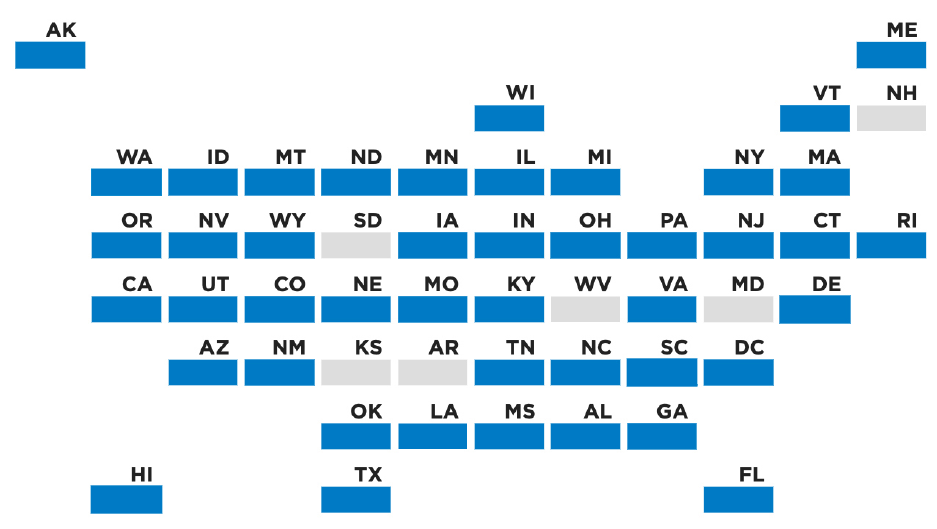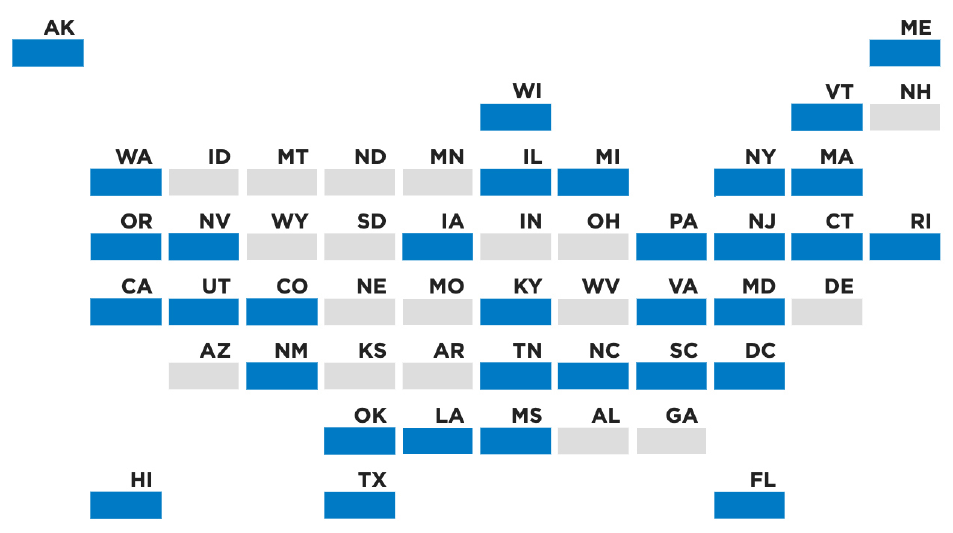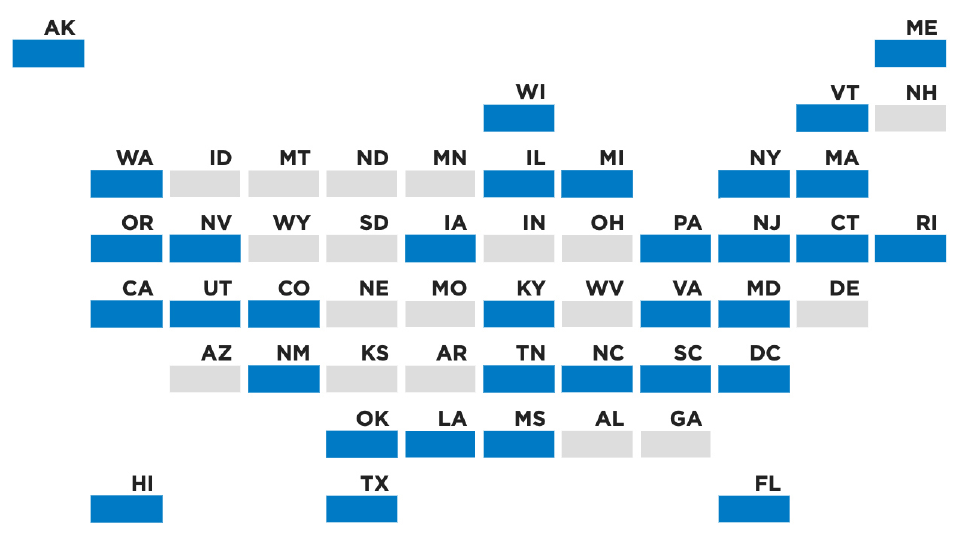
• Continuing to pay child care providers who accept subsidies during this period of closure or low
attendance
7
• Providing emergency care through temporary regulatory changes and additional funding to providers
who offer care for children of essential workers
8
• Waiving or covering a portion of child care tuition that families may otherwise be required to pay
9
Originally conducted in
April 2020, this snapshot of state policies has been updated and is current as of
June 17, 2020.
a
It
does not encompass all policy changes
as a result of the emergency funding. Child
Trends sourced information from the Alliance for Early Success’ COVID-19 State Actions resource, the
Hunt Institute’s COVID-19 Resources and Policy Considerations resource, and the U.S. Administration for
Children and Families’ Child Care Waiver Approval Summary document to inform this scan.
10,11,12
For
additional information on individual state decisions, the National Women’s Law Center recently conducted
a survey of state child care administrators and released a report that will be updated as state policies
continue to shift.
13
States Are Using the CARES Act to Improve
Child Care Access during COVID-19
Elizabeth Bedrick and Sarah Daily
June 2020
Child care plays a vital role in our nation’s economy.
1
COVID-19 has largely shut down child care programs
and schools across the nation, presenting challenges for working parents.
2
Child care closures are a
particularly acute problem for frontline and essential workers—health care personnel, grocery store staff,
postal and delivery service workers, and many others who need to physically report to work. At the same
time, child care providers across the nation are struggling to stay financially secure under these dire
circumstances.
3
The Coronavirus Aid, Relief, and Economic Security (CARES) Act included $3.5 billion in
emergency funds for the Child Care and Development Block Grant, and the federal Administration for
Children and Families issued guidance to allow states more flexibility in meeting Child Care and
Development Fund (CCDF) requirements to mitigate the effects of the pandemic.
4,5,6
These measures
enable states to help families and child care providers get the support they desperately need.
A new policy scan from Child Trends shows that states are using these emergency funds to improve the
affordability of care and increase provider compensation. Specifically, states are:
The analysis for this brief was initially conducted in April 2020. However, to best reflect both the rapidly changing policy
environment and states’ evolving responses to COVID-19, this brief was updated on June 17, 2020. The brief was
subsequently updated again on July 6, 2020 to reflect newly identified data provided by Maryland on the state’s use of
CARES Act funds.

States Are Using the CARES Act to Improve Child Care Access During COVID-19
2
44 states and Washington, DC are continuing to pay child care providers
who accept subsidies during this period of closure or low attendance.
These measures are to prevent permanent child care closures as a result of the pandemic, which would
hinder many families from returning to work and slow recovery across the nation; and to incentivize
programs to stay open at lower capacity to care for children of essential workers. Many states are offering
both of these resources to financially support providers. For example, Ohio providers are eligible to take
21 “pandemic days” during closure, where the value of one day is based on the number of hours that each
child would have been in care.
14

States Are Using the CARES Act to Improve Child Care Access During COVID-19
3
3
1 states and Washington, DC are providing additional funding to child
care providers who offer care to children of essential workers.
This action is to incentivize providers to remain open and to adequately compensate providers that stay
open during this health crisis. For example, Connecticut is providing additional funding to both licensed
center-based and licensed home-based child care providers who serve children of essential workers;
funding provided can be up to $825 per week and is based on the number of children a provider serves.
15
States are also paying child care providers higher rates for certain groups of children who receive
subsidies. For example, Vermont is incentivizing child care providers to serve school-age children of
essential workers who would otherwise have been in school by paying them a total of $325 per child each
week.
16

States Are Using the CARES Act to Improve Child Care Access During COVID-19
4
3
2 states and Washington, DC are waiving or covering a part of child
care tuition that families may otherwise be required to pay.
This response is to relieve cost burdens on families who may otherwise have had to drop out of child care
and help providers maintain a steady stream of revenue. For example, Washington state is waiving all fees
for families who receive subsidies for the months of April, May, and June.
17
Looking forward
States are continuing to determine the best use of federal dollars to support children, families, and
providers during the COVID-19 pandemic. These maps represent a snapshot of states’ immediate activities
for ensuring continued compensation for providers, affordability of care for essential workers, and
stabilization of the economy. As states move toward recovery, they can consider several other ways to
utilize the emergency funds to support families and providers:
• Ease employment requirements for accessing subsidies as millions of unemployed families struggle to
find work.
• Offer financial support to providers who may need to comply with extra health and safety guidelin
es
as they resume operations,
as described in the CARES Act.
18
• Provide professional development and support for programming that cover topics of relevance to the
crisis, including trauma, grief, and family engagement.
• Track child care supply and enrollment data to ensure that the most vulnerable children receive care.
While states have made clear their plans for supporting child care, more data is needed to know how often
and to what extent these policies are being implemented. Child Trends plans to monitor how states are
allocating federal funds as the crisis evolves.

States Are Using the CARES Act to Improve Child Care Access During COVID-19
5
References
1
Early Learning Policy Group (n.d.). The Economic Impact of Child Care within States. Retrieved from
https://www.earlylearningpolicygroup.com/childcare-economic-impact.html
2
National Association for the Education of Young Children (2020). Child Care in Crisis: Understanding the
Effects of the Coronavirus Pandemic. Retrieved from https://www.naeyc.org/sites/default/files/globally-
shared/downloads/PDFs/our-work/public-policy-advocacy/effects_of_coronavirus_on_child_care.final.pdf
3
Zero to Three (2020). How COVID-19 is Impacting Child Care Providers. Retrieved from
https://www.zerotothree.org/resources/3398-how-covid-19-is-impacting-child-care-
providers#downloads
4
Office of Child Care (2020). Summary of Child Care Provisions of Coronavirus Aid, Relief, and Economic
Security Act of “CARES Act.” Administration for Children & Families, U.S. Department of Health & Human
Services. Retrieved from https://www.acf.hhs.gov/occ/resource/summary-of-child-care-provisions-of-
cares-act
5
Office of Child Care (2017). Flexibility in Spending CCDF Funds in Response to Federal or State Declared
Emergency Situations. Administration for Children & Families, U.S. Department of Health & Human
Services. Retrieved from https://www.acf.hhs.gov/occ/resource/im-2017-02
6
Office of Child Care (2016). Overview of 2016 Child Care and Development Fund Rule. Administration for
Children & Families, U.S. Department of Health & Human Services. Retrieved from
https://www.acf.hhs.gov/sites/default/files/occ/ccdf_final_rule_fact_sheet.pdf
7
Child Care Aware of America (2020). State by State Resources. Retrieved from
https://www.childcareaware.org/resources/map/
8
The Hunt Institute (2020). COVID-19 Policy Considerations
: Supporting Child Care During the Crisis.
Retrieved from http://www.hunt-institute.org/resources/2020/04/covid-19-policy-playbook-supporting-
child-care-during-the-crisis/
9
National Center on Subsidy Innovation and Accountability (2018). CCDF Family Co-Payments and Sliding
Fee Scales. Early Childhood Training and Technical Assistance System, Office of Child Care, Administration
for Children & Families, U.S. Department of Health & Human Services. Retrieved from
https://childcareta.acf.hhs.gov/sites/default/files/public/family_co-payment_brief_0.pdf
10
Alliance for Early Success (2020). Child Care Subsidy and Payment Changes in Response to COVID-19.
Retrieved from http://earlysuccess.org/resources/coronavirus
11
The Hunt Institute (2020). COVID-19 Resources & Policy Considerations. Retrieved from
http://www.hunt-institute.org/covid-19-resources/state-child-care-actions-covid-19/
12
Office of Child Care (2020). Child Care Waiver Approval Summary. Administration for Children & Families,
U.S. Department of Health & Human Services. Retrieved from
https://www.acf.hhs.gov/sites/default/files/occ/summary_of_waiver_approvals.pdf
13
Schulman, K. (2020). Child Care’s Struggle to Survive COVID-19: State Impacts and Responses. National
Women’s Law Center. Retrieved from https://nwlc.org/resources/child-cares-struggle-to-survive-covid-
19-state-impacts-and-responses/
14
Ohio Office of Family Assistance (2020). Publicly Funded Child Care During the COVID-19 Pandemic.
Department of Job and Family Services. Retrieved from http://jfs.ohio.gov/cdc/docs/PFCC-during-
COVID-Pandemic-04-08-2020.pdf
15
Connecticut Office of Early Childhood (2020). CTCARES for Child Care Program. Retrieved from
https://www.ctoec.org/covid-19/ctcares-programs/ct-cares-for-child-care/

States Are Using the CARES Act to Improve Child Care Access During COVID-19
6
16
Vermont Child Development Division (2020). Frequently Asked Questions about Child Care COVID-19
Financial Support Programs. Department for Children and Families, Agency of Human Services. Retrieved
from https://dcf.vermont.gov/sites/dcf/files/CDD/Docs/COVID/Child-Care-Financial-Supports-FAQs.pdf
17
Washington State Department of Children, Youth & Families (2020). Child Care and Early Learning
Provider COVID-19 Update. Retrieved from
https://content.govdelivery.com/accounts/WADEL/bulletins/2859e5b
18
Office of Child Care (2020). Summary of Child Care Provisions of Coronavirus Aid, Relief, and Economic
Security Act or “CARES Act.” Retrieved from https://www.acf.hhs.gov/occ/resource/summary-of-child-
care-provisions-of-cares-act
